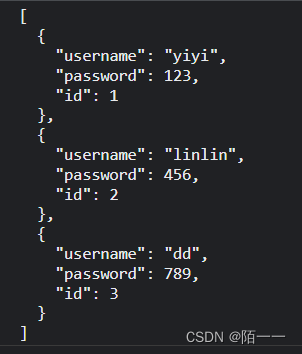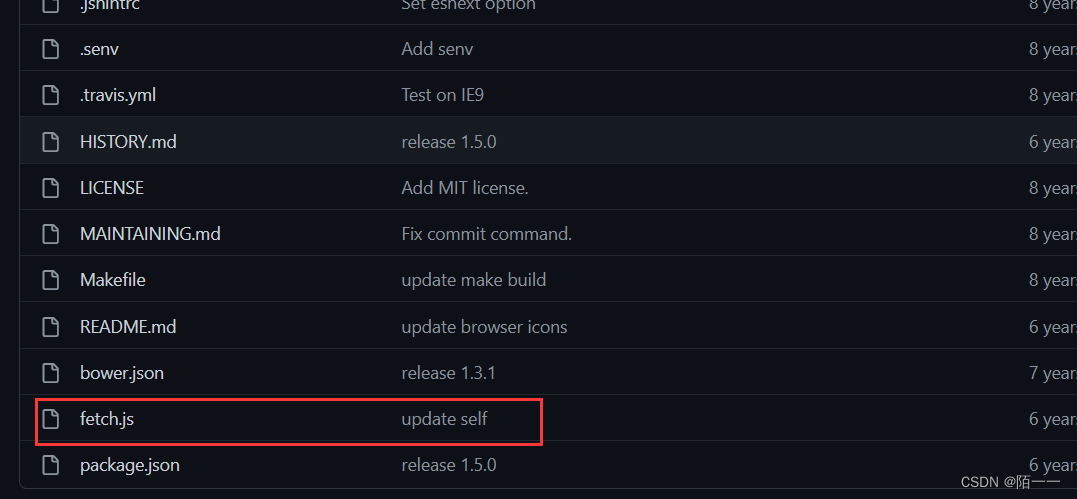1、什么是fetch:
fetch是ES6出现的,它使用了 ES6 提出的 promise 对象,为了取代XMLHttpRequest而诞生的;
提到XMLHttpRequest就不得不提ajax,ajax是一种实现前后端交互的技术,而ajax是基于XMLHttpRequest模块实现的;
但是因为XMLHttpRequest是一个设计粗糙的API,配置和调用方式非常混乱,而且基于事件的异步模型写起来不友好;
所以使用XMLHttpRequest模块会产生回调地狱问题,因此产生了fetch,fetch是用来取代XMLHttpRequest模块的,并不是取代ajax的。
- 不同于ajax的XMLHttpRequest方式,这个fetch代码非常的简洁,fetch也是服务于ajax技术,建立前后端连接,实现前后端数据交互的;
2、fetch的用法:
fetch用来解决回调地狱问题;
http请求方式不同,写法也会不一样,不同的请求方式可以实现数据库的数据的增删改查;
常用的请求方式有:get()、post()、put()、patch()、delete();
get():拿到数据库里所有的数据;
post():增加数据;
put()、patch():修改数据;
delete():从数据库中删除数据;
(1)get请求方式:
(默认请求方式是get方式)
格式:fetch(url).then(回调函数).then(回调函数)
<body>
<button id="myget">get</button>
<script>
myget.onclick = function(){
//get方式fetch请求
fetch("http://localhost:3000/users").then(res=>{
// console.log(res)
return res.json()
}).then(res=>{
console.log(res) //res就是请求回来的数据
})
}
</script>
</body>
用fetch的含义是:朝fetch里的地址发起请求,请求数据,最后打印,res就是请求回来的数据。
✌
代码解释:
打印第一个then里的res结果:
console.log(res) //第一个then的res- 第一个then,接收的res不是数据,里面没有数据;
- 数据在res.json里,意思是把我的数据按照json格式读出来,但是直接打印res.json那拿不到数据,因为res.json也是一个promise对象,所以要return作为一个返回值在第二个then中才能拿到url里的数据。
结果:

打印res.json:
- 拿数据的时候,要返回这个res.json,在链式then里面接收这个数据res,res.json直接输出的结果不是数据,是一个Promise对象;
console.log(res.json())结果:
![]()
这个res.json也可以换成res.text,只不过res.json是转换成数组包裹的json对象,res.text是转换成json字符串格式,看下面的区别:
res.json格式:

res.text格式:

✌
get方式传参数:
-
get方式是从数据库中获取数据,传参数也是为了规定从数据库里读取什么样的数据;
我们先看怎么传参数:
get请求默认是把参数传在地址上,
格式是:在地址后面加上“?参数”
看fetch括号里面的地址,用
“?”关键字
把参数写在地址后面;
代码中的
参数是:“username=${username}”
<script>
myget.onclick = function(){
let username = "yiyi"
fetch(`http://localhost:3000/users?username=${username}`).then(res=>{
// console.log(res)
return res.json()
}).then(res=>{
console.log(res)
})
}
</script>假如没有传参数之前请求回来的完整数据是下图:(json格式数据)
{
"users": [
{
"username": "yiyi",
"password": 123,
"id": 1
},
{
"username": "linlin",
"password": 456,
"id": 2
},
{
"username": "dd",
"password": 789,
"id": 3
}
]
}这个数据也相当于数据库里的完整数据了,因为get方式是从数据库中读取数据,上面代码中get方式传的参数是“{username=yiyi}”,参照数据库那就是读取id=1的数据,读取完后的结果:

(2)post方式:(和get方式,就多了一个对象参数,其他都一样)
post方式:是携带传给后端的数据的,传参数是写在body里面
携带的信息可分为两种格式:表单格式和json字符串格式
post方式含义也是往数据库里新增数据;
表单格式的post请求:
fetch("http://localhost:3000/users",{
method:'POST',
headers:{
"content-type":"application/x-www-form-urlencoded"
},
body:"username=yiyi&password=123"
})get方式只需要传一个url地址就可以了,但是post是携带信息的,所以需要给fetch传第二个参数;
第二个参数是一个对象,里面放着method(请求方式)、headers(信息格式)、body(携带的信息);
表单方式和json字符串格式的headers和body不同;
headers写的是表单格式,body里的数据就要写成表单格式;headers写的是json格式,body里的数据就要写成json格式;
表单格式的header和body格式是:
header:{“content-type”:”application/x-www-form-urlencoded”}
body:“键=值&键=值”
注意:body里千万不要传成对象格式,不然就解析不了了;
json格式的post请求:
- 就把fetch里的headers和body参数换成下面这个格式就行了,其他的一样:
fetch("http://localhost:3000/users",{
method:'POST',
headers:{
"content-type":"application/json"
},
body:JSON.stringify({
username:"yiyi",
password:"123"
})
})
json字符串格式的header和body格式是:
header:{“content-type”:”application/json”}
body:JSON.stringify({键:”值”,键:“值”})
- ps:为什么要加上stringify,因为括号里是对象格式,body不能接收对象格式,所以前面是加上JSON.stringify把对象格式转化为json字符串格式。
(3)put请求方式:
put方式的含义是对数据库的数据进行修改;
跟post相比较,把method和地址改了;
把method改为“PUT”;在请求地址
http://localhost:3000/users
后面加上你要修改的json文件里id为几的对象,代码中加了“/1”,说明是修改id为1的对象;
fetch("http://localhost:3000/users/1",{
method:'PUT',
headers:{
"content-type":"application/json"
},
body:JSON.stringify({
username:"yiyi",
})
})请求回来的json文件数据:
{
"users": [
{
"username": "yiyi",
"password": 123,
"id": 1
},
{
"username": "linlin",
"password": 456,
"id": 2
},
{
"username": "dd",
"password": 789,
"id": 3
}
]
}
代码解释:
代码中地址是“/1”,代表要修改id=1所在的对象信息,body里携带的是修改信息,把json文件中id=1的对象修改为: “username“:”yiyi”,修改完json文件为:
{
"users": [
{
"username": "yiyi",
"id": 1
},
{
"username": "linlin",
"password": 456,
"id": 2
},
{
"username": "dd",
"password": 789,
"id": 3
}
]
}put方式是整个覆盖修改,对象里的所有值都被新来的信息覆盖。
(4)patch方式:
patch方式:跟put含义一样,是修改数据库的值,把method为“PATCH”;
但是区别是:put是整个覆盖,patch是部分修改;
看代码:
fetch("http://localhost:3000/users/1",{
method:'PATCH',
headers:{
"content-type":"application/json"
},
body:JSON.stringify({
username:"haha",
})
})json文件:(数据库完整数据)
{
"users": [
{
"username": "yiyi",
"password": 123,
"id": 1
},
{
"username": "linlin",
"password": 456,
"id": 2
},
{
"username": "dd",
"password": 789,
"id": 3
}
]
}修改后:只是把id=1的username改成了传过来的值“haha”,password不变
{
"users": [
{
"username": "haha",
"password": 123,
"id": 1
},
{
"username": "linlin",
"password": 456,
"id": 2
},
{
"username": "dd",
"password": 789,
"id": 3
}
]
}
(5)delete请求方式:
-
delete是删除数据的,参数也是在地址上加“id”,选定哪一个就删除哪一个
fetch("http://localhost:3000/users/1",{
method:'DELETE'
})
3、fetch方法不能用catch捕获错误
虽然fetch方法能解决回调地狱问题,但是fetch不能用catch主动捕获错误,就是出错了,它不会就去走catch了,它还会继续往下执行,所以出错了需要自己去处理;
请求数据会出现问题:
要么是地址填错了,填的地址没有数据;要么是地址是正确的,因为别的原因数据请求不回来,网络的问题也有可能。
那怎么找出错误是哪里出现的呢,上面我们有在控制台上打印过res这个值;
<body>
<button id="myget">get</button>
<script>
myget.onclick = function(){
fetch("http://localhost:3000/users").then(res=>{
console.log(res)
})
}
</script>
</body>这个res值的结果是:

结果中有一个ok这个值和status状态这个值,ok这个值是当请求成功就是ture,请求失败就是false; status是请求成功为200,请求失败为404;
看ok简单一点,所以我们拿ok是true或者false来判断是否出错;
所以我们要在第一个then后面输出一下res的值,而且要进行if条件判断,
然后自己进行处理:
fetch(`http://localhost:3000/users?username=${username}`).then(res=>{
console.log(res)
if(res.ok){
return res.json()
}else{
//拒绝
//reject后面{}放着拒绝以后要返回的值,可以自己定义,一般是返回status和
return Promise.reject({
status:res.status,
statusText:res.statusText
})
}
}).then(res=>{
console.log(res)
}).catch(err=>{
console.log("error",err)
})如果请求不成功,也就是ok为false时,我们要主动拒绝,因为这个then默认你不写promise对象,也没有主动拒绝,它后面这个链式then就会直接调用。
我们在上面进行if判断,出错了就会走else,就会返回promise对象,里面有status当前状态,和statusText:数据是否返回成功。
测试案例:
这时候如果我们把地址填错,代码的执行是,先执行第一个then,先打印res,也就是console.log(res),然后发现ok是false,请求失败,这样就会执行拒绝的代码:return Promise.reject({})返回一个promise对象然后去执行catch里的代码,实参是promise.reject({实参})这里面大括号里面的实参,也就是:
{status:res.status,statusText:res.statusText},catch里面的err是形参,最后输出结果:
地址填错拒绝时返回的结果:

请求成功时它就会给你把数据拿回来:

完整代码:get方式:
<body>
<button id="myget">get</button>
<script>
myget.onclick = function(){
let username = "yiyi"
fetch(`http://localhost:3000/users?username=${username}`).then(res=>{
console.log(res)
if(res.ok){
return res.json()
}else{
//拒绝
//reject后面{}放着拒绝以后要返回的值,可以自己定义,一般是返回status和
return Promise.reject({
status:res.status,
statusText:res.statusText
})
}
}).then(res=>{
console.log(res)
}).catch(err=>{
console.log("error",err)
})
}
</script>
</body>
post方式:
<body>
<button id="myget">get</button>
<!-- <button id="mypost">post</button>
<button id="myput">put</button>
<button id="mypatch">patch</button>
<button id="mydelete">delete</button> -->
<script>
myget.onclick = function(){
fetch("http://localhost:3000/users",{
method:'POST',
headers:{
"content-type":"application/x-www-form-urlencoded"
},
body:"username=yiyi&password=123"
})
.then(res=>{
console.log(res)
if(res.ok){
return res.json()
}else{
//拒绝
//reject后面{}放着拒绝以后要返回的值,可以自己定义,一般是返回status和
return Promise.reject({
status:res.status,
statusText:res.statusText
})
}
})
.then(res=>{
console.log(res)
}).catch(err=>{
console.log("error",err)
})
}
</script>
</body>
4、fetch的缺点
fetch最大的问题就是:存在浏览器的兼容性,
推荐一个网站:
Can I use… Support tables for HTML5, CSS3, etc
这个网站能查询方法,技术在各个浏览器的兼容性问题
红色表示不支持,黄色表示部分支持,绿色表示支持;

不支持的浏览器,可以使用
polyfill
这个兼容性的库,把库用script标签引入,名字为:fetch.js,
polyfill库:
GitHub – camsong/fetch-ie8: A window.fetch JavaScript polyfill supporting IE8
找到里面的fetch.js文件:

这个库表面上是fetch,但是里面的代码还是基于XMLHttpRequest设计的;
fetch的使用:
fetch是在promise基础上封装出来的,fetch是不用借助于任何模块任何js文件的,是内置的一个功能,直接用,不需要引入任何文件什么的。
但需要兼容浏览器的话,就把上面这个
polyfill库引入进来。